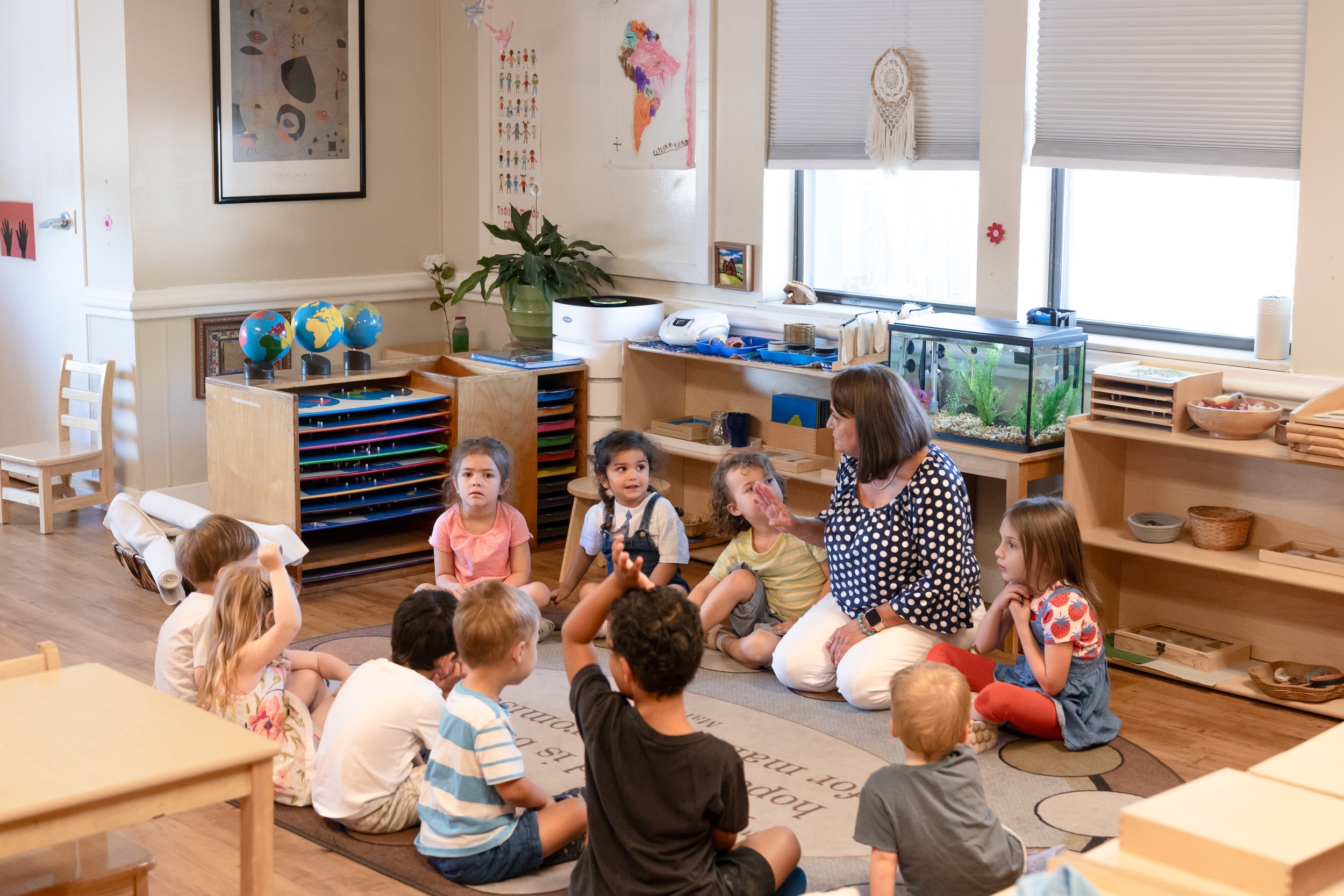Primary Montessori Program
Ages 3 – 6
Our three bright and roomy Primary classrooms are intentionally designed to inspire self-directed learning. Classes are composed of mixed-age groups to allow for cognitive stimulation while also meeting each child’s social needs.

We nurture their curiosity & love for learning
At our Primary Level, we cultivate a passion for learning through interactive exploration, personalized instruction, and a profound respect for each child's unique developmental path. We have three bright and spacious primary classrooms and a large playground area to serve children from 3 to 6 years old. Within these mixed-age groups, children learn and advance at their own pace in a respectful, non-competitive atmosphere. They learn from each other.
Children are free to move around, choose the material or activity they will use, and determine whether they will work alone or with a friend. Teachers interact with one child at a time or in a small group, demonstrating the use of the materials and recording each child’s progress. As children learn and grow, they progress individually at their own pace, from practical life exercises to sensory and academic materials. Our Primary program follows the traditional Montessori 3-year cycle. This is such a critical component of an authentic Montessori education.
Join us in guiding your child through this pivotal stage of growth and discovery within our nurturing and supportive educational community.
CLASSROOM AREAS
Our Primary program nurtures and enhances each child's innate curiosity and enthusiasm for learning. The youngest students start by observing and learning from their older peers, who guide them in the classroom. By the end of their Primary journey, these children undergo a remarkable transformation, evolving into the leaders themselves.
Movement
In Montessori education, outdoor physical activity is a key focus. Each day, students are given dedicated time to be outside and engage in movement. They benefit from both free play on outdoor equipment and structured physical activities, which help them stay active and learn about taking care of their bodies. Children are welcome to explore the various gardening beds & help with planting & watering. Our ample outdoor space, with various activities provides plenty of opportunity for free play & physical activity.
The classroom is divided in areas set up in a big open space, where children can move and walk freely to choose activities. The furniture is sized appropriately for the children and all the possible work environments are in place to allow independent discovery.
Practical Life
By engaging in purposeful and stimulating tasks with real, child-friendly materials - such as pouring, spooning, baking, preparing food, sweeping, tying shoelaces, flower arranging & so on - children enhance their fine motor skills, hand-eye coordination, and ability to focus and stay organized. These activities also help develop crucial life skills, including self-care, environmental responsibility, and manners, setting a solid foundation for independence and self-confidence. Practical life activities build gross and fine motor skills and coordination as well as develop concentration. There are many tasks, such as care of self (e.g., dressing, tying shoes, etc.), caring for the environment, and exercises to develop hand-eye coordination, presented to enable the child to build competence and independence through practice and repetition.
Language
The classroom is a natural extension of the patterns of communication that have already been absorbed. Through every conversation, every book read aloud, every new word that is taught, the Primary level student is learning language, and thus, learning to read. Knowledge is constructed by mental and physical activity rather than on passive learning. In the Montessori 3-6 Language curriculum, writing itself is seen as a direct preparation for reading.The child is taught language through a specific progression of lessons where he first becomes aware of the different sounds in a word. The child then learns the language phonetically until the point where he is taught the different “rules” in a given language and the exceptions to those rules he will need to know in order to spell and read fluently.
Mathematics
A large part of early Montessori math is learning how to associate quantities with numerals! Children are able to learn this concept through the Bead Stair, Spindle Boxes, and Cards and Counters. With the Bead Stair children learn to match bead chains with 1 bead up to 9 beads with their associated numerals. The child first learns to count from 1-10 through the understanding of the concept that those numbers represent a specific amount. Through each material, the child will learn addition, subtraction, multiplication and division and truly understand what each one means in their deeper sense. Through this method of teaching, Montessori offers the child a strong and solid foundation in the understanding of mathematics.
Sensorial
The Sensorial Curriculum in Montessori serves as more than just a tool for memory enhancement; it provides a crucial foundation for all learning in this environment. Each material used in sensorial teaching is crafted to highlight a specific quality, such as weight, texture, shape, color, smell, size, or sound. The materials are designed to help children build basic problem-solving skills, improve their sense of perception, and begin abstract thinking. Dr. Montessori's Sensorial Curriculum predates modern concepts of "sensory play," introducing the innovative idea of systematically training a child's sensory system from an early age.
Geography
Through sensory experience and the use of imaginative stories, children in the Montessori 3-6 environment learn about their physical world. They can touch a sphere and compare the shape to the globe. They build landforms using play dough and fill water forms with water. Montessori materials have specific colors designated for each continent: Africa is green, Asia is yellow, Australia is brown, Antarctica is white, South America is pink, North America is orange, and Europe is red.








